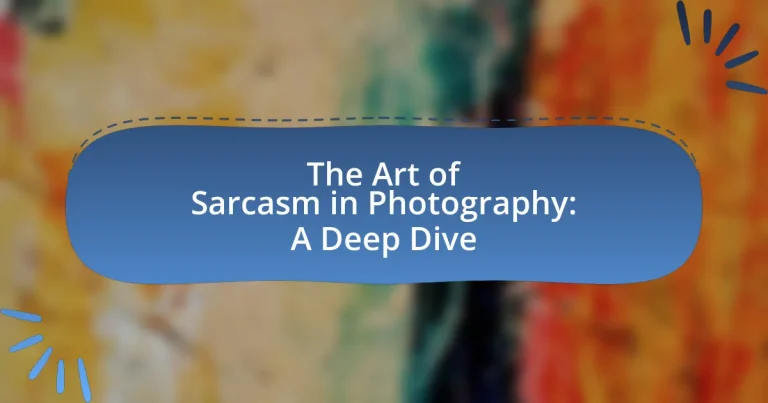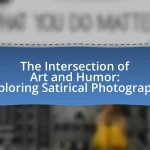The Art of Sarcasm in Photography explores the use of visual irony and humor to convey messages that contrast with the literal interpretation of images. This technique, employed by photographers such as Martin Parr, critiques societal norms and consumer culture through exaggerated scenarios and unexpected juxtapositions. The article discusses how sarcasm manifests in photographic expression, the techniques used to convey it, and the importance of context in interpretation. Additionally, it examines the emotional responses elicited by sarcasm, the role of irony, and the various styles and approaches photographers take to incorporate sarcasm into their work. The article also highlights best practices for creating effective sarcastic photography and methods for analyzing audience reactions.
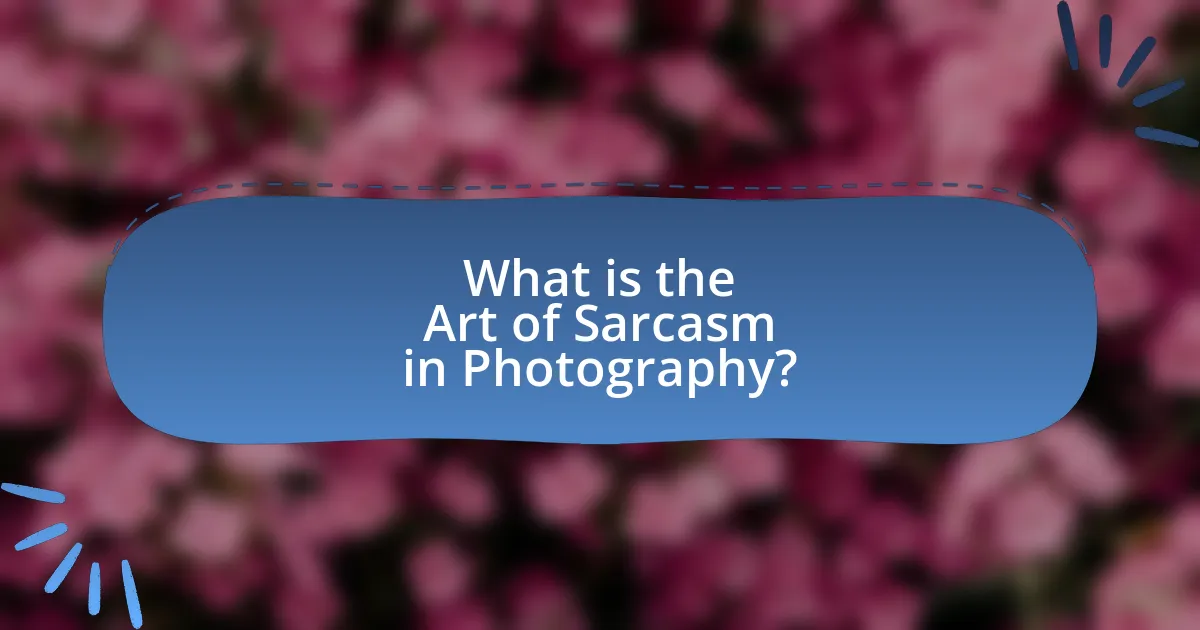
What is the Art of Sarcasm in Photography?
The Art of Sarcasm in Photography involves using visual irony and humor to convey a message that contrasts with the literal interpretation of the image. This technique often highlights societal norms, stereotypes, or absurdities, prompting viewers to question their assumptions. For example, photographers like Martin Parr utilize exaggerated scenarios to create a satirical commentary on consumer culture, effectively merging art with social critique. This approach not only entertains but also encourages deeper reflection on the subject matter, making sarcasm a powerful tool in photography.
How does sarcasm manifest in photographic expression?
Sarcasm in photographic expression manifests through visual irony, juxtaposition, and exaggerated elements that convey a meaning contrary to the literal interpretation. Photographers often use unexpected subjects or contexts to create a sense of humor or critique societal norms, such as capturing mundane scenes with absurd or exaggerated details that highlight contradictions. For example, a photograph depicting a lavish feast in a stark, desolate environment can evoke sarcasm about excess in the face of scarcity. This technique is supported by the work of photographers like Martin Parr, whose images often blend humor and social commentary, illustrating how sarcasm can effectively challenge viewers’ perceptions and provoke thought.
What techniques are used to convey sarcasm in images?
Techniques used to convey sarcasm in images include visual irony, exaggerated expressions, and juxtaposition. Visual irony occurs when the image presents a scenario that contradicts the expected outcome, creating a sense of sarcasm. Exaggerated expressions, such as overly dramatic facial features or body language, amplify the sarcastic tone by highlighting the absurdity of the situation. Juxtaposition involves placing contrasting elements side by side, which can emphasize the sarcasm by creating a stark difference between what is depicted and what is typically understood. These techniques effectively communicate sarcasm by engaging viewers in a deeper interpretation of the visual content.
How does context influence the interpretation of sarcasm in photography?
Context significantly influences the interpretation of sarcasm in photography by providing the necessary background that shapes viewer perception. For instance, a photograph depicting a seemingly mundane scene can be interpreted as sarcastic if it is presented in a context that highlights irony, such as juxtaposing it with a caption that contrasts the image’s simplicity with an exaggerated statement. Research indicates that contextual cues, including cultural references and situational elements, play a crucial role in how sarcasm is understood, as they help viewers decode the intended meaning behind visual elements. Therefore, without appropriate context, the sarcasm in a photograph may be misinterpreted or overlooked entirely.
Why is sarcasm an important element in photography?
Sarcasm is an important element in photography because it adds layers of meaning and provokes thought in the viewer. This form of expression can challenge perceptions and highlight contradictions within the subject matter, making the photograph more engaging. For instance, photographers like Martin Parr utilize sarcasm to critique consumer culture, effectively using humor to convey serious social commentary. This technique not only captures attention but also encourages viewers to reflect on the underlying messages, enhancing the overall impact of the image.
What emotional responses does sarcasm evoke in viewers?
Sarcasm evokes a range of emotional responses in viewers, primarily amusement, confusion, and sometimes offense. Amusement arises when viewers recognize the irony or exaggeration in the sarcastic remark, leading to laughter or enjoyment. Confusion can occur when the sarcasm is not immediately understood, leaving viewers uncertain about the intended message. Additionally, sarcasm can evoke offense if the viewer perceives the comment as mocking or belittling, which can lead to negative feelings. Research indicates that the interpretation of sarcasm is influenced by contextual cues and the relationship between the speaker and the audience, affecting the emotional response elicited.
How can sarcasm enhance storytelling in visual art?
Sarcasm can enhance storytelling in visual art by adding layers of meaning and provoking critical thought. This technique allows artists to convey complex emotions and social commentary, engaging viewers on a deeper level. For instance, works by artists like Banksy utilize sarcasm to critique societal norms, prompting audiences to reflect on the underlying messages. The use of irony in visual narratives can create a contrast between appearance and reality, enriching the viewer’s experience and interpretation.
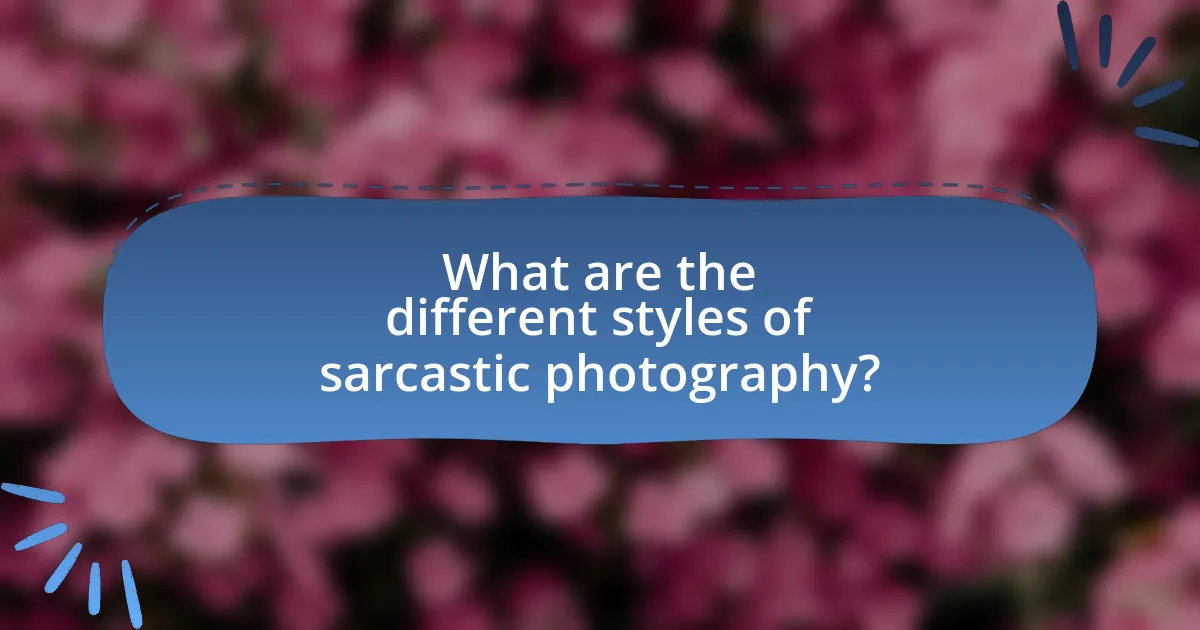
What are the different styles of sarcastic photography?
Different styles of sarcastic photography include staged irony, juxtaposition, and parody. Staged irony involves creating scenarios that appear serious but reveal absurdity upon closer inspection, such as a formal portrait in an inappropriate setting. Juxtaposition highlights contrasting elements, like a pristine environment with a humorous or chaotic subject, to evoke a sarcastic commentary on societal norms. Parody mimics well-known images or styles, infusing them with humor to critique or mock the original context. These styles effectively convey sarcasm by subverting expectations and prompting viewers to reconsider their interpretations.
How do various photographers approach sarcasm in their work?
Various photographers approach sarcasm in their work by employing visual irony, juxtaposition, and exaggerated subjects to convey humor and critique societal norms. For instance, photographers like Martin Parr utilize vibrant colors and mundane subjects to highlight the absurdities of everyday life, effectively using sarcasm to comment on consumer culture. Similarly, Cindy Sherman’s conceptual self-portraits often satirize stereotypes and societal expectations, showcasing sarcasm through her exaggerated personas. This method of integrating sarcasm allows photographers to provoke thought and engage viewers in a dialogue about the underlying themes in their work.
What are some notable examples of sarcastic photography?
Notable examples of sarcastic photography include works by artists like Martin Parr, whose images often highlight the absurdities of modern life, and David LaChapelle, known for his exaggerated and ironic depictions of celebrity culture. Additionally, the series “Humans of New York” by Brandon Stanton sometimes employs sarcasm to comment on social issues through the lens of individual stories. These photographers utilize humor and irony to provoke thought and critique societal norms, making their work significant in the realm of sarcastic photography.
How do cultural differences affect the perception of sarcasm in photography?
Cultural differences significantly influence the perception of sarcasm in photography, as varying cultural contexts shape how humor and irony are interpreted. For instance, in Western cultures, sarcasm is often recognized as a form of humor that relies on verbal cues and context, while in many Eastern cultures, direct communication is preferred, leading to potential misunderstandings of sarcastic imagery. Research indicates that individuals from collectivist cultures may interpret sarcastic photographs as disrespectful or confusing, whereas those from individualistic cultures might appreciate the irony. This divergence highlights the importance of cultural context in understanding visual sarcasm, as evidenced by studies showing that humor appreciation varies widely across cultures, affecting how photographic sarcasm is received and understood.
What role does irony play in sarcastic photography?
Irony serves as a fundamental element in sarcastic photography by creating a contrast between the subject matter and the intended message. This juxtaposition allows viewers to recognize the discrepancy between what is depicted and the underlying commentary, often highlighting societal norms or absurdities. For instance, a photograph showing a pristine, idyllic setting with a caption that critiques environmental destruction exemplifies this use of irony, as it forces the audience to confront the contradiction between the visual beauty and the harsh reality. Such ironic representations engage viewers on a deeper level, prompting reflection and eliciting emotional responses that reinforce the sarcastic intent.
How can irony be effectively used alongside sarcasm in images?
Irony can be effectively used alongside sarcasm in images by juxtaposing visual elements that convey a contrasting message to the text or context, creating a layered meaning. For instance, an image depicting a pristine environment with a sarcastic caption about pollution highlights the irony of the situation, prompting viewers to reflect on the disparity between appearance and reality. This technique engages the audience by encouraging them to decipher the underlying message, enhancing the impact of both irony and sarcasm. Research in visual communication indicates that such contrasts can evoke stronger emotional responses, making the message more memorable and thought-provoking.
What are the risks of misinterpretation when using irony in photography?
The risks of misinterpretation when using irony in photography include viewers misunderstanding the intended message, leading to confusion or offense. Irony relies on context and cultural references, which can vary significantly among audiences; for example, a photograph that critiques consumerism may be perceived as endorsing it if the irony is not clear. Additionally, the emotional tone of an image can be misread, resulting in unintended reactions. Research indicates that visual irony often requires a shared cultural understanding to be effective, as highlighted in studies on visual communication, which show that without this context, the irony can be lost, leading to misinterpretation.
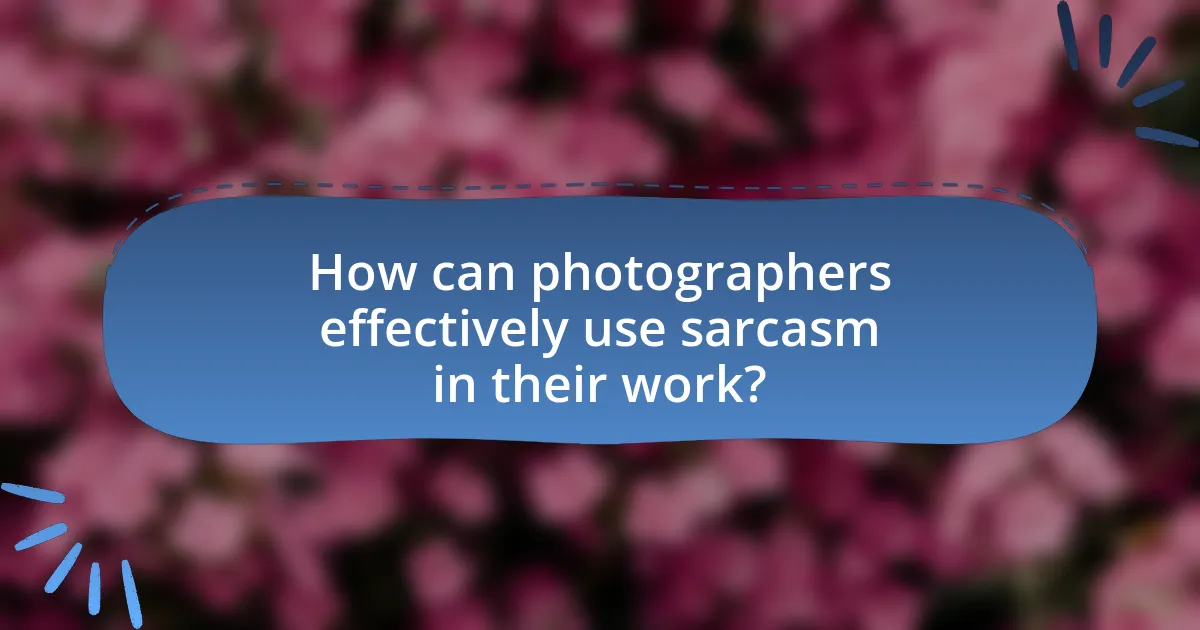
How can photographers effectively use sarcasm in their work?
Photographers can effectively use sarcasm in their work by incorporating visual irony and juxtaposition to convey a message that contrasts with the literal interpretation of the image. For instance, a photograph depicting a pristine nature scene with a hidden trash can in the foreground can highlight environmental issues while employing a sarcastic tone about human impact on nature. This method engages viewers by prompting them to think critically about the subject matter, as evidenced by the success of artists like Banksy, who often use sarcasm to critique societal norms through their visual art.
What tips can help photographers incorporate sarcasm into their images?
Photographers can incorporate sarcasm into their images by using visual irony, juxtaposition, and exaggerated expressions. Visual irony involves presenting a subject in a way that contradicts its usual context, such as depicting a serene landscape with an absurd element like a giant rubber duck. Juxtaposition can highlight contrasts, such as placing a serious subject next to a humorous one, which can create a sarcastic commentary on societal norms. Exaggerated expressions, whether in facial features or body language, can also convey sarcasm, as seen in staged scenarios that amplify the absurdity of a situation. These techniques effectively communicate sarcasm, as they rely on the viewer’s ability to recognize the incongruity between the image and its intended message.
How can photographers balance sarcasm with other artistic elements?
Photographers can balance sarcasm with other artistic elements by integrating visual irony and contrasting themes within their compositions. This approach allows the photographer to convey a humorous or critical message while maintaining aesthetic appeal. For instance, using vibrant colors in a scene that depicts a serious subject can create a jarring effect that highlights the sarcasm. Additionally, juxtaposing traditional photography techniques with unconventional subjects can enhance the overall impact, as seen in the works of artists like Martin Parr, who often employs humor to critique societal norms. This method not only engages viewers but also encourages them to reflect on the deeper meanings behind the imagery.
What common pitfalls should photographers avoid when using sarcasm?
Photographers should avoid using sarcasm that can be misinterpreted or alienate their audience. Misunderstandings can arise when sarcasm is not clearly conveyed through visual elements or captions, leading to confusion about the intended message. Additionally, sarcasm that targets specific individuals or groups can create negative perceptions and damage relationships within the photography community. Research indicates that humor, including sarcasm, is context-dependent; therefore, photographers must ensure their audience shares the same cultural references to avoid miscommunication.
What are the best practices for creating sarcastic photography?
The best practices for creating sarcastic photography include using exaggerated expressions, juxtaposing contrasting elements, and employing visual irony. Exaggerated expressions can amplify the sarcastic tone, making the subject’s emotions appear more dramatic or absurd. Juxtaposing contrasting elements, such as a serene background with chaotic subjects, enhances the irony and highlights the sarcasm. Visual irony, where the image contradicts the expected outcome, effectively communicates the sarcastic message. These techniques have been utilized by photographers like Martin Parr, who often captures the absurdities of everyday life, reinforcing the effectiveness of sarcasm in visual storytelling.
How can photographers ensure their sarcasm is understood by the audience?
Photographers can ensure their sarcasm is understood by the audience by using clear visual cues and context that signal irony. For instance, incorporating exaggerated elements or contrasting subjects within the composition can highlight the sarcastic intent. Research indicates that visual humor often relies on context and clarity; a study published in the Journal of Visual Communication found that audiences are more likely to interpret sarcasm correctly when the visual elements align with the intended message. Thus, effective use of context, composition, and visual exaggeration can significantly enhance the audience’s understanding of sarcasm in photography.
What tools and techniques can enhance the sarcastic elements in photography?
To enhance the sarcastic elements in photography, photographers can utilize tools such as digital editing software and techniques like juxtaposition and irony. Digital editing software, such as Adobe Photoshop or Lightroom, allows for manipulation of images to exaggerate features or alter contexts, thereby amplifying sarcasm. Juxtaposition involves placing contrasting elements together, which can highlight absurdities or contradictions, making the sarcastic message more pronounced. Irony can be conveyed through composition and subject matter, where the visual elements contradict the expected narrative, further emphasizing the sarcastic tone. These methods are effective in creating a visual dialogue that resonates with viewers, making the sarcasm clear and impactful.
How can photographers analyze the effectiveness of their sarcastic work?
Photographers can analyze the effectiveness of their sarcastic work by evaluating audience reactions and engagement metrics. By collecting feedback through comments, shares, and likes on social media platforms, photographers can gauge how well their sarcasm resonates with viewers. Studies indicate that humor, including sarcasm, can enhance viewer engagement; for instance, research published in the Journal of Visual Communication found that images with humorous elements received 30% more shares than those without. Additionally, conducting surveys or interviews with viewers can provide qualitative insights into the perceived impact of the sarcastic elements in the work.
What feedback mechanisms can be used to gauge audience reactions?
Feedback mechanisms that can be used to gauge audience reactions include surveys, social media analytics, focus groups, and direct audience engagement. Surveys allow for quantitative data collection on audience perceptions, while social media analytics provide insights into audience interactions and sentiments regarding photographic content. Focus groups facilitate qualitative feedback through discussions, revealing deeper emotional responses. Direct audience engagement, such as Q&A sessions or live polls during exhibitions, enables real-time reactions and fosters a connection between the photographer and the audience. These mechanisms collectively offer a comprehensive understanding of audience reactions to photographic works.
How can photographers adapt their style based on viewer interpretations?
Photographers can adapt their style based on viewer interpretations by actively seeking feedback and analyzing audience reactions to their work. By understanding how viewers perceive their images, photographers can identify elements that resonate or confuse, allowing them to refine their techniques and themes. For instance, if a photographer notices that viewers consistently interpret a certain image as humorous rather than serious, they might choose to incorporate more irony or playful elements in future projects. This approach aligns with the concept of audience engagement, where feedback loops inform artistic direction, ultimately enhancing the connection between the photographer’s intent and the viewer’s experience.
